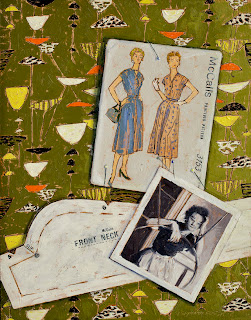La Fem Sophistique is a dress shop in Sacramento CA that only sells vintage designer clothing. They loaned this dress to me so I could make a graphite drawing of it. When it was finished, I sent the dress back along with the drawing and it now hangs in their shop.
Designer earned wide acclaim for flaunt-it fashion
OBITUARIES : Eletra Casadei, 1953 - 2008
Eletra Casadei, the California fashion designer whose prom dresses put
away the Sweet Sixteen look and moved into strapless, backless, slit-to-here
styles, has died. She was 55.
She died Sept. 27 at her home in Pacific Palisades. The cause was
brain cancer, her sister Andrea Casadei Best said.
One of the first Los Angeles designers of her generation to gain a
national reputation for something other than swimwear, Casadei claimed Old
Hollywood glamour as her inspiration and fantasy dresses at affordable prices
as her niche.
She introduced her TD4 (To Die For) line in the late 1970s for
customers ages 14 and up. Before long their mothers were wearing the clothes
and she launched a second collection, Casadei, for them. By the early 1980s, a
boom time for flaunt-it fashion, Casadei was in her stride.
"Padded shoulders, draping, appliques, sequins, Eletra's evening
dresses were over the top and a lot of fun," Pam Roberts, the designer's
former publicist, told The Times.
Throughout the 1980s, Casadei's collections were carried in some 7,000
boutiques and department stores, most of them in the U.S. Prices ranged from
about $100 to about $400.
A former fashion model, she wore her own designs and added a few
accents, such as plum color streaks in her hair and iridescent fuchsia nail
polish.
Dresses from her collections turned up on sitcoms and soaps as diverse
as "Golden Girls," about four older women rooming together, and
"Dynasty," about Denver socialites with glitzy tastes.
Casadei's best advertisements were the two fashion-music videos she
created in the mid-1980s, modeled after the music videos that aired on MTV.
Instead of costumes, she used dresses from her latest collection.
"Eletra pioneered fashion-music videos," Janet Orsi, another
former publicist, said this week. "The idea was to capitalize on the music
video phenomenon and marry it to fashion. Designers got to show their clothes
in a new genre. It was a change from the typical fashion show."
Casadei's videos played in stores and wholesale showrooms as well as
on MTV. She played the lead in "Adventures of the Countess," a
mystery made in the style of a silent movie with scary mood music.
Her other video, "Prom Night," with a soundtrack of Steve
Winwood music, shows girls at a dance that gets a lot more exciting when guys
in black leather show up.
Casadei was born July 5, 1953, in the east San Francisco Bay community
of Hayward, where she won the title "Maid of Hayward" as a teenager.
She graduated from Loyola Marymount University in Los Angeles, majoring in
business administration. Her first job, as a store buyer, was frustrating.
"She was always wishing she could change the way the clothes were
designed," Casadei's sister said.
She taught herself the skills of fashion design and opened a business
office in downtown L.A.
Casadei scaled back her operation in the '90s but became known for her
remakes of the most popular celebrity dresses at the Academy Award shows. Her
version of the vintage Valentino gown that actress Julia Roberts wore in 2001
sold for $169.
Most recently she designed under the Casadei by Eletra Casadei label
and owned a boutique in Pacific Palisades where she sold her ready-to-wear
styles and made custom-order clothes. She continued working until a few weeks
ago.
Casadei's only marriage ended in divorce. In addition to her sister,
she is survived by her son, Nico Casadei Roe; her mother, Verna Casadei; and
another sister, Janelle Brunelli.
A
memorial service is planned for 3 p.m. Oct. 11 at Corpus Christi Church, 887
Toyopa Drive, Pacific Palisades.


























